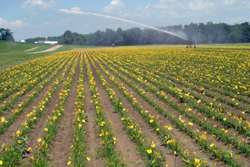Ornamental plant nurseries need to understand costs to remain profitable (Part 2)
In this second article of a three-part series, learn about MSU Extension’s new, low-cost financial management software that will help nursery growers manage their business. A workshop on the software will be offered at the Great Lakes Expo.
The nursery industry in Michigan and across the nation has experienced some financial challenges in recent years due to the economy’s downturn and subsequently a slower demand for herbaceous perennials, shrubs and trees.
Growers need to evaluate their production costs and plant inventory to determine if adjustments need to be made to stay competitive. To accomplish this, growers need to have a good handle on their costs. MSU Extension has developed inexpensive software to help you evaluate your nursery business from a financial perspective. “Estimating the Wholesale Cost of Nursery Production” is an Excel spreadsheet type of software tool that allows you to use your records to estimate your production costs and to explore opportunities for cost savings.
This is the second of three articles that will help you understand how this software works and how to use it to help your nursery remain profitable and even grow your business’ bottom line. Read the first article of this series, “Ornamental plant nurseries need to understand costs to remain profitable (Part 1),” and the third, "Ornamental plant nurseries need to understand costs to remain profitable (Part 3)."
 The Enterprises worksheet is used to describe the enterprises that will be tracked throughout the rest of the spreadsheet. Enterprises can be set up however the user wishes to track crops that are produced. For example, one user may choose to track crops for a particular species while another may choose to do so by final product size.
The Enterprises worksheet is used to describe the enterprises that will be tracked throughout the rest of the spreadsheet. Enterprises can be set up however the user wishes to track crops that are produced. For example, one user may choose to track crops for a particular species while another may choose to do so by final product size.
This spreadsheet can track up to 100 separate enterprises, so for nurseries with product mixes less than 100, each product can be tracked. For nurseries with larger product mixes, crops will need to be grouped into similar cost categories unless the user is proficient with Excel. It is possible to expand the number of enterprises the spreadsheet can track, but since the worksheets are interlinked and calculations from one worksheet are used in other worksheets, a thorough knowledge of Excel is needed. If the user desires to increase the number of enterprises, they should be sure to retain an original copy of the spreadsheet in case errors are made.
The Income worksheet captures information from the previous year through sales, materials and labor cost records, inventory and tax returns. These figures are used to calculate total income, direct costs, indirect costs, total expenses and net business income. Total income, direct costs and total expenses are used only as a comparison to estimated costs in the other worksheets. Indirect costs are used to estimate an indirect cost for the year being evaluated.
The next few worksheets (Fertilizer, Pesticide, Substrate, Overwintering, and Labor Help) are help sheets to determine costs per production unit (usually one plant). For example, in the Fertilizer worksheet the user enters the amount of fertilizer added per container or per acre, the bulk cost, the amount in the bulk container, any conversion factor needed to convert the bulk container units into the applied unit, the number of applications per production cycle, and a 1 for container production or the number of plants per acre for field production. These values are used to calculate the fertilizer cost per production unit for each enterprise.
Costs from all of the help sheets except the Labor Help worksheet are carried forward to the Cost of Production worksheet.Since labor costs for certain operations are similar regardless of the crop, these costs are grouped on the help sheet to minimize inputs, but need to be manually transferred to the Cost of Production worksheet.
To order a copy of this software, go to the MSU Extension Bookstore website and type in DVD-029 in the “Search” box to begin your ordering process.
The authors will be offering a four-hour, hands-on workshop to teach you how to use this software at the MNLA Great Lakes Trade Expo in Grand Rapids, Mich. on Tuesday, January 10, 2012. This will take place at the Devos Place from 8:00 a.m. to noon. For more details on the workshop, contact Tom Dudek by email or phone (616-994-4580) or the above website for the GLTE.



 Print
Print Email
Email

